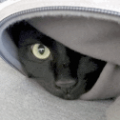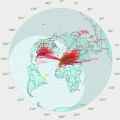G8JNJ
About
- Username
- G8JNJ
- Joined
- Visits
- 4,628
- Last Active
- Roles
- Member
- Points
- 127
Reactions
-
Adding Kiwi to my website
Hi All,
Details of my 'Loop on the ground' (or technically just above it) can be found on this webpage.
https://www.g8jnj.net/loop-on-the-ground
Treat the page as a preview as it's more of a working notebook and not really fit for publication yet.
It may also contain some errors and content that will eventually be removed if I decide it's not really worthy of inclusion.
I hope it may encourage other KiWi owners to experiment, as I've found it to be about 10dB more sensitive than typical 1m diameter loops. Although it's still about 5dB below the sensitivity required to hear galactic noise throughout the 20-30MHz frequency range.
The S/N stats on http://rx.linkfanel.net/ (although not very accurate) currently show my KiWi and LOG to have a value of just under 32dB, which is probably amongst the best of all KiWi's worldwide.
For comparison purposes most Kiwi's using 1m loops shown on the site typically manage around 20dB and most E-Probes achieve about 15dB.
You can take a listen to my KiWi using a 10ft per side loop and pre-amplifier on this url http://southwest.ddns.net:8073
Regards,
Martin - G8JNJ -
RSDN-20 beacons reactivated on 11.9, 12.65 & 14.9KHz
Hi All,
The Russian RSDN-20 beacons on 11.9, 12.65 & 14.9KHz are active once again after quite a long absence.
They must have found some more coins for the electricity meter down the back of their sofa.
Signals are about 8-10dB above the noise floor on my Kernow KiWi SDR in the SW of the UK.
If you use this URL it will provide enhanced contrast on the waterfall display.
http://kernow.hopto.org:8073/?sqrt=2
The signal on 14.9KHz seems to have a second weaker transmission slotted in between the stronger 'pips', which you can just about see in the screen grab.
Regards,
Martin - G8JNJ -
v1.360+: DRM extension now available
Hi John & All Happy New Year to everyone.
Even if it's not possible to decode DRM because the KiWI is occupied, could it be made so that you can still open up the DRM schedule screen so that you can select and tune to stations to see if they are transmitting DRM, even if it's not possible to decode it at the time ?
Also if the DRM extension is selected but the KiWi is occupied, could the DRM extension wait and reserve a slot, but start working when the KiWi has become clear for use ?
Regards,
Martin - G8JNJ -
Using WSPR data to compare antennas
Hi All,
Based on Stu's comments in another thread
>
>If you did make a database one thing I'd really like is the ability to run two or more systems and break down which works better on a band.
>
I thought it may be useful to outline he processes I use to make antenna measurements with WSPR and other similar methods that make use of KiWi web sdr's.
First using WSPR.
WSPR does not report received signal level, but the signal to noise ratio of an individual WSPR transmission as received at the reporting station.
Individual reporting stations will have differing S/N ratios, depending upon the location, antenna, receiver and frequency in use. They also have different propagation paths from the transmitting station.
Therefore you can only compare 'like with like' and derive a delta, not an absolute value.
In order to be able to do this a minimum of two stations are required, which can either be two (or more) transmitting stations as received by one reporting station e.g. one transmit location with two separate antennas and transmitters, or one transmitting station as received by two (or more) reporting stations e.g. one receive location with two separate antennas and receivers.
To be valid data points, the sets of reports being analysed have to be contained within the same two minute time window as each other.
In order to minimise 'outlying' data points it's good practice to be able to exclude S/N values that are outside certain limits. e.g above +10dB as many receive systems compress above this value and also below -25dB as random noise badly distorts the reported value when it becomes closer to the system detection threshold of around -30dB.
WSPR only reports in 1dB steps, so this limits the absolute accuracy that can be obtained. However it is possible to interpolate by using methods such as curve fitting. e.g. plot the distribution of spots for one transmission as received by one reporter. These could be visualised as a horizontal axis of S/N values with 35 vertical bars representing -25dB to +10dB and the vertical axis representing the number of spots of that particular value were reported. If a curve is then 'fitted' to the distribution of the bars, and the peak of the curve is found on the horizontal axis, then the averaged value to sub dB accuracy can be derived.
This is why I like to transmit at 100% duty cycle, as I have often noticed that some spotting stations have a cyclic variation in reported S/N values, when another local WSPR station transmits during one of the receive time slots and either de-sensitises the receiver or operates the receiver AGC, both of which produce a variation in the reported S/N ratio during that time slot. This can be seen as two or more distinct peaks in the distribution curve. In which case either the complete data set can be discarded or the lower sets of values ignored, although this will still slew the results slightly, and should only be used if you are really desperate.
If the curve is not very precise or flat, then either there are not enough spots, or there is too much variation in S/N values and the data sets should be discarded.
The derived S/N values can then be compared against each other and another delta bar graph histogram can be produced and curve plotted to derive a final result.
If this process is repeated for a number of time slots, sets of stations and different bearings, it is possible to produce a polar plot scattergram, showing the differences between two (or more) different antennas.
However as you can imagine all of this is very time consuming to perform manually and it is just crying out for some sort of automated process to be implemented. Something like the WSPRLite system which is a subscription service.
https://www.dxplorer.net/wsprlite/
The sequence I follow to measure the delta between two transmit antennas is as follows:-
Setup two transmitters with different callsigns, each one on a different antenna.
I usually use a vertical 1/4 wave as the 'reference' antenna, as this is omni-directional and easy to model. The other antenna and transmitter is the one 'under test'.
Transmit on one band for 1 hour at 100% ratio, so that I can quickly collect lots of spots, in all the time slots, before the propagation changes too significantly to distort the results.
It's best to do this mid morning or mid afternoon so that grey line and other relatively rapid propagation changes are not occurring.
Collect the hours worth of spots from WSPRNET, discard any reports above +10dB or below -25dB, match signals into the same time slots, discard any sets of signals that do not have a full set of reports in each time slot e.g. only one station reported.
Plot distribution bargraph and curve fit to find average S/N value for each station and reporter pair.
Compare average S/N value for transmitter 1 and transmitter 2 and calculate difference. If there are many reporting stations, plot distribution bargraph of delta S/N values and curve fit to find sub dB average value for each reporting 'pair'.
Use bearing information to produce polar plot scattergram, showing differences in radiation pattern.
The process of comparing two receive antennas is very similar, just substitute the word receiver for transmitter in the above example.
I also use a similar process by comparing signal strengths, but I have to do this manually by comparing KiWi signal strength graphs whilst monitoring plain carriers from two transmitters, if comparing transmit antennas, or AM broadcast stations, if comparing receive antennas.
I usually plot these consecutively over a 2 minute period and note the maximum signal level during that period. This has to be done by 'eyeballing' the graph, which is not as accurate as would be desired as the scaling is in 10dB intervals and it's not currently possible to download the data for off-line analysis in the form of a .csv or .txt file. Although it may be possible to use kiwirecorder.py to perform this function. Once again the manual analysis is very laborious and time consuming.
I hope this provides some 'food for thought' and that it would be possible to provide an alternative to the WSPRNET database which is creaking under the strain, and in addition be able to provide more useful on-line analysis tools that would be of great benefit to the community.
Regards,
Martin - G8JNJ -
Using WSPR data to compare antennas
Hi All,
Based on Stu's comments in another thread
>
>If you did make a database one thing I'd really like is the ability to run two or more systems and break down which works better on a band.
>
I thought it may be useful to outline he processes I use to make antenna measurements with WSPR and other similar methods that make use of KiWi web sdr's.
First using WSPR.
WSPR does not report received signal level, but the signal to noise ratio of an individual WSPR transmission as received at the reporting station.
Individual reporting stations will have differing S/N ratios, depending upon the location, antenna, receiver and frequency in use. They also have different propagation paths from the transmitting station.
Therefore you can only compare 'like with like' and derive a delta, not an absolute value.
In order to be able to do this a minimum of two stations are required, which can either be two (or more) transmitting stations as received by one reporting station e.g. one transmit location with two separate antennas and transmitters, or one transmitting station as received by two (or more) reporting stations e.g. one receive location with two separate antennas and receivers.
To be valid data points, the sets of reports being analysed have to be contained within the same two minute time window as each other.
In order to minimise 'outlying' data points it's good practice to be able to exclude S/N values that are outside certain limits. e.g above +10dB as many receive systems compress above this value and also below -25dB as random noise badly distorts the reported value when it becomes closer to the system detection threshold of around -30dB.
WSPR only reports in 1dB steps, so this limits the absolute accuracy that can be obtained. However it is possible to interpolate by using methods such as curve fitting. e.g. plot the distribution of spots for one transmission as received by one reporter. These could be visualised as a horizontal axis of S/N values with 35 vertical bars representing -25dB to +10dB and the vertical axis representing the number of spots of that particular value were reported. If a curve is then 'fitted' to the distribution of the bars, and the peak of the curve is found on the horizontal axis, then the averaged value to sub dB accuracy can be derived.
This is why I like to transmit at 100% duty cycle, as I have often noticed that some spotting stations have a cyclic variation in reported S/N values, when another local WSPR station transmits during one of the receive time slots and either de-sensitises the receiver or operates the receiver AGC, both of which produce a variation in the reported S/N ratio during that time slot. This can be seen as two or more distinct peaks in the distribution curve. In which case either the complete data set can be discarded or the lower sets of values ignored, although this will still slew the results slightly, and should only be used if you are really desperate.
If the curve is not very precise or flat, then either there are not enough spots, or there is too much variation in S/N values and the data sets should be discarded.
The derived S/N values can then be compared against each other and another delta bar graph histogram can be produced and curve plotted to derive a final result.
If this process is repeated for a number of time slots, sets of stations and different bearings, it is possible to produce a polar plot scattergram, showing the differences between two (or more) different antennas.
However as you can imagine all of this is very time consuming to perform manually and it is just crying out for some sort of automated process to be implemented. Something like the WSPRLite system which is a subscription service.
https://www.dxplorer.net/wsprlite/
The sequence I follow to measure the delta between two transmit antennas is as follows:-
Setup two transmitters with different callsigns, each one on a different antenna.
I usually use a vertical 1/4 wave as the 'reference' antenna, as this is omni-directional and easy to model. The other antenna and transmitter is the one 'under test'.
Transmit on one band for 1 hour at 100% ratio, so that I can quickly collect lots of spots, in all the time slots, before the propagation changes too significantly to distort the results.
It's best to do this mid morning or mid afternoon so that grey line and other relatively rapid propagation changes are not occurring.
Collect the hours worth of spots from WSPRNET, discard any reports above +10dB or below -25dB, match signals into the same time slots, discard any sets of signals that do not have a full set of reports in each time slot e.g. only one station reported.
Plot distribution bargraph and curve fit to find average S/N value for each station and reporter pair.
Compare average S/N value for transmitter 1 and transmitter 2 and calculate difference. If there are many reporting stations, plot distribution bargraph of delta S/N values and curve fit to find sub dB average value for each reporting 'pair'.
Use bearing information to produce polar plot scattergram, showing differences in radiation pattern.
The process of comparing two receive antennas is very similar, just substitute the word receiver for transmitter in the above example.
I also use a similar process by comparing signal strengths, but I have to do this manually by comparing KiWi signal strength graphs whilst monitoring plain carriers from two transmitters, if comparing transmit antennas, or AM broadcast stations, if comparing receive antennas.
I usually plot these consecutively over a 2 minute period and note the maximum signal level during that period. This has to be done by 'eyeballing' the graph, which is not as accurate as would be desired as the scaling is in 10dB intervals and it's not currently possible to download the data for off-line analysis in the form of a .csv or .txt file. Although it may be possible to use kiwirecorder.py to perform this function. Once again the manual analysis is very laborious and time consuming.
I hope this provides some 'food for thought' and that it would be possible to provide an alternative to the WSPRNET database which is creaking under the strain, and in addition be able to provide more useful on-line analysis tools that would be of great benefit to the community.
Regards,
Martin - G8JNJ






